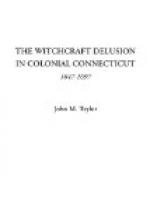The ministers stood with the magistrates in their delusion and intemperate zeal. Two hundred and sixteen years after the last witch was hung in Massachusetts a clearer light falls on one of the striking personalities of the time—Cotton Mather—who to a recent date has been credited with the chief responsibility for the Salem prosecutions.
Did he deserve it?
Robert Calef, in his More Wonders of the Invisible World, Bancroft in his History of the United States, and Charles W. Upham in his Salem Witchcraft, are the chief writers who have placed Mather in the foreground of those dreadful scenes, as the leading minister of the time, an active personal participant in the trials and executions, and a zealot in the maintenance of the ministerial dignity and domination.
On the other hand, the learned scholar, the late William Frederick Poole, first in the North American Review, in 1869, and again in his paper Witchcraft in Boston, in 1882, in the Memorial History of Boston, calls Calef an immature youth, and says that his obvious intent, and that of the several unknown contributors who aided him, was to malign the Boston ministers and to make a sensation.
And the late John Fiske, in his New France and New England (p. 155), holds that:
“Mather’s rules (of evidence) would not have allowed a verdict of guilty simply upon the drivelling testimony of the afflicted persons, and if this wholesome caution had been observed, not a witch would ever have been hung in Salem.”
What were those rules of evidence and of procedure attributed to Mather? Through the Special Court appointed to hold the witch trials, and early in its sittings, the opinions of twelve ministers of Boston and vicinity were asked as to witchcraft. Cotton Mather wrote and his associates signed an answer June 15, 1692, entitled, The Return of Several Ministers Consulted by his Excellency and the Honorable Council upon the Present Witchcrafts in Salem Village. This was the opinion of the ministers, and it is most important to note what is said in it of spectral evidence,[E] as it was upon such evidence that many convictions were had:
“1. The afflicted state of our poor neighbors that are now suffering by molestations from the Invisible World we apprehend so deplorable, that we think their condition calls for the utmost help of all persons in their several capacities.
“2. We cannot but with all thankfulness acknowledge the success which the merciful God has given unto the sedulous and assiduous endeavors of our honorable rulers to detect the abominable witchcrafts which have been committed in the country; humbly praying that the discovery of these mysterious and mischievous wickednesses may be perfected.
“3. We judge that, in the prosecution of these and all such witchcrafts there is need of a very critical and exquisite caution, lest by too much credulity for things received only upon the devil’s authority, there be a door opened for a long train of miserable consequences, and Satan get an advantage over us; for we should not be ignorant of his devices.




